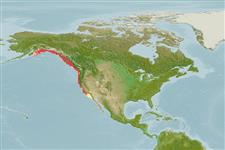>
Perciformes/Scorpaenoidei (Scorpionfishes) >
Sebastidae (Rockfishes, rockcods and thornyheads) > Sebastinae
Etymology: Sebastes: Greek, sebastes = august, venerable (Ref. 45335); pinniger: From the Latin pinna and gero, connoting 'fin' and 'to bear' (Ref. 27436).
More on author: Gill.
Environment: milieu / climate zone / depth range / distribution range
экология
морской демерсальный; пределы глубины 0 - 838 m (Ref. 55644), usually 90 - 270 m (Ref. 36715). Subtropical; 61°N - 31°N, 154°W - 116°W
Eastern Pacific: south of the Shelikof Strait in the Gulf of Alaska to Cape Colnett, Baja California, Mexico.
Length at first maturity / Size / Вес / Возраст
Maturity: Lm 44.0, range 27 - 54 cm
Max length : 76.0 cm FL самец/пол неопределен; (Ref. 3496); наибольший вес (опубликованные данные): 4.5 kg (Ref. 4699); наибольший возраст (опубликованны данные): 84 годы (Ref. 39247)
Краткое описание
определительные ключи | морфология | морфометрия
колючие лучи спинного плавника (общее число) : 13; членистые (мягкие) лучи спинного плавника (общее число) : 14 - 15; колючие лучи анального плавника: 3; членистые (мягкие) лучи анального плавника: 7. Head spines strong to moderate - nasal, preocular, supraocular, postocular, tympanic and parietal spines present, coronal and nuchal spines absent (Ref. 27437). Scales on lower jaw embedded; anal fin with a strong anterior slant (Ref. 27437). Caudal fin strongly indented (Ref. 6885). Bright yellow to orange mottled on a gray background; 3 orange stripes across head; fins orange; specimens less than 35.56 cm with dark markings on posterior part of spinous dorsal; gray along lateral line (Ref. 27437).
Adults hover in loose groups above rocky bottoms (Ref. 27436). Pelagic juveniles are found in shallower water (Ref. 27436). Feed on small fishes and krill (Ref. 2850). Viviparous, with planktonic larvae (Ref. 36715). Validated age by radiometry is 44 yrs (Ref. 49687). Flesh is of good quality (Ref. 27436). Sold as fillets (Ref. 27436).
Ovoviviparous (Ref. 6885).
Eschmeyer, W.N., E.S. Herald and H. Hammann, 1983. A field guide to Pacific coast fishes of North America. Boston (MA, USA): Houghton Mifflin Company. xii+336 p. (Ref. 2850)
Статус Красного Списка МСОП (Ref. 130435)
Использование человеком
рыболовство: коммерческий; объект спортивного рыболовства: да; аквариум: общественные аквариумы
дополнительная информация
инструменты
Специальные отчеты
Скачать в формате XML
ресурсы в Интернет
Estimates based on models
Preferred temperature (Ref.
123201): 4.7 - 8.3, mean 5.9 °C (based on 144 cells).
Phylogenetic diversity index (Ref.
82804): PD
50 = 0.5000 [Uniqueness, from 0.5 = low to 2.0 = high].
Bayesian length-weight: a=0.01000 (0.00499 - 0.02004), b=3.09 (2.92 - 3.26), in cm total length, based on LWR estimates for this Genus-body shape (Ref.
93245).
Trophic level (Ref.
69278): 3.8 ±0.61 se; based on food items.
устойчивость к внешним воздействиям (Ref.
120179): низкий, минимальное время удвоения популяции 4.5-14 лет (tm=7; tmax=84; Musick et al. 2000 (Ref.
36717); Fec=85,000 (annual fecundity)).
Prior r = 0.20, 95% CL = 0.13 - 0.31, Based on 1 full stock assessment.
Fishing Vulnerability (Ref.
59153): High vulnerability (62 of 100).
Climate Vulnerability (Ref.
125649): Moderate to high vulnerability (45 of 100).
Nutrients (Ref.
124155): Calcium = 38.1 [11.8, 124.3] mg/100g; Iron = 0.661 [0.265, 1.673] mg/100g; Protein = 18.5 [17.3, 19.6] %; Omega3 = 0.751 [0.329, 1.720] g/100g; Selenium = 106 [39, 337] μg/100g; VitaminA = 15.7 [5.7, 45.8] μg/100g; Zinc = 0.427 [0.216, 0.811] mg/100g (wet weight); based on
nutrient studies.
